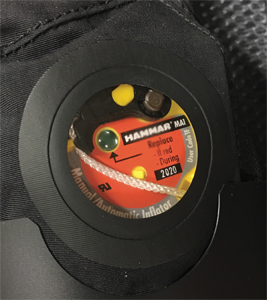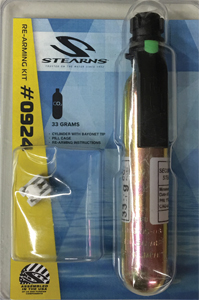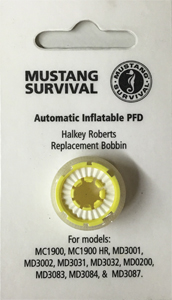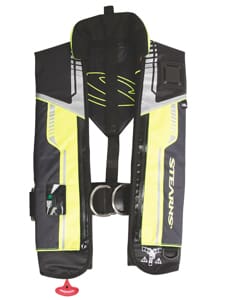Inflatable personal flotation devices (PFDs) have found their way aboard most vessels and have become a recognized alternative to traditional foam-filled life jackets thanks to their ease of use, comfort and effectiveness. But in spite of their convenience and effectiveness, unlike their static counterparts they do require care and regular maintenance if they are to perform and protect as designed.
How they work
Most automatic inflatable PFDs are activated by a chemical bobbin that dissolves in water. When the bobbin falls apart, it allows a spring-loaded firing pin to puncture a carbon dioxide cylinder, which, in turn, inflates the PFD.
Should the PFD fail to inflate, it can be manually inflated using the pull-tab lanyard, which will also puncture the cylinder, or orally inflated via an inflation tube.
Other methods of activation include a hydrostatic mechanism such as Mustang Survival’s HIT (hydrostatic inflator technology). This device relies on water pressure to activate the valve built into the life vest. Waves and rain will have no effect on the pressure valve, which must be immersed in four inches of water before it activates. These PFDs are also equipped with a pull-tab lanyard for manual inflation and an oral inflation tube should the hydrostatic device fail.
 |
|
A hydrostatic activator on a Mustang inflatable PFD. |
|
John Snyder |
Regardless of the style of the activator, all inflatable PFDs should be inspected at the beginning of each season and at regular intervals thereafter, depending on use.
Inspection and maintenance
All straps, buckles and harness attachment points should be examined for wear and damage, especially to the stitching and zippers if applicable. The exterior covering, which contains and protects the inflatable air bladder, should also be checked for rips and other damage.
The inflatable PFD should then be opened up to expose the air bladder. The bladder should be inspected for holes, damage or wear, especially along the seams. Once laid out, orally inflate the PFD and let it remain filled overnight to see if any leaks can be detected. You can also place the PFD in fresh water to look for air bubbles leaking out.
Let the PFD air dry thoroughly in a cool dry place. Next, inspect the activation mechanism. Is there a date printed on it and is it current? Bobbin-equipped devices note the date of manufacture, not expiration; hydrostatic devices show an expiration date. Is the inflator status indicator green or red? Some activation devices have two status indicators, so check your product manual if you are not sure where they are located. For inflatable PFDs with a chemical bobbin activator, be sure that the indicator is green and, if possible, visually check to see that the chemical agent has not dissolved or is discolored as a result of exposure to moisture. Do not attempt to dry out the bobbin if it has gotten wet; just replace it and the CO2 cylinder. Do not attempt to repack or re-arm the inflatable PFD until it is completely dry.
 |
|
A Stearns recharge package includes a new CO2 cartridge and replacement bobbin. |
|
John Snyder |
Check to see that the CO2 cylinder is securely attached to the device. Some CO2 cartridges screw in and others use a bayonet mount. The screw-in type must be firmly connected; the bayonet type must be pushed in and turned clockwise until it reaches a stop. In some cases the green indicator will not be visible without fully turning the cylinder, and if it is not properly in place the unit will not inflate.
Some manufacturers claim that properly cared for bobbins will last about three years, but, for example, Stearns Flotation recommends replacing the bobbin and CO2 cartridge yearly, regardless of use. Also, be sure to note the date you replaced the activator and cartridge with a waterproof marker somewhere on one of the PFD’s labels.
Inflatable PFDs with hydrostatic activators like those offered by Mustang Survival have gained in popularity, especially in commercial and offshore applications. Since they are activated by water pressure, they are not susceptible to moisture or spray and are less likely to fail. If they are properly cared for, hydrostatic inflators can go without maintenance for up to five years, at which time the activator and CO2 cartridge are simply replaced. Again, note the date of replacement somewhere on the PFD. Hydrostatically activated PFDs are more expensive than bobbin-activated units. Their added benefits may very well outweigh the additional expense, especially in very wet environments or where a saltwater dousing is a regular occurrence.
Regardless of the activation mechanism, the basics of overall inflatable PFD inspection and maintenance remain the same. Before use they should always be checked and determined to be “in the green” and ready for activation. Some PFDs have a clear window for quick confirmation; on others, a flap may need to be opened to expose the indicator. Also, always be sure that the manual pull-tab is accessible and is not restricted in any way so you can get at it quickly in an emergency.
 |
|
A replacement bobbin for Mustang units. |
|
John Snyder |
Ensure that you have adjusted the straps to comfortably fit over your clothing, and that the buckles are secure. If the PFD is equipped with an integral harness, be confident that you know where to attach the safety tether and how to quickly release it. If items such as strobe lights, personal locator beacons or whistles are attached to the PFD, make sure that they are securely attached, have been function checked before use, and do not in any way interfere with the deployment of the air bladder.
When not in use, inflatable PFDs should be stored in a cool dry place. Take care not to leave them in the sun or cram them into drawers or tight spaces where abrasion or puncture might occur. Ideally they should be hung up in a dry locker for easy access. If a harness is incorporated into the PFD, its tether should be clipped into one of the D-rings and stored with it.
Contributing editor John Snyder is a marine writer and photographer based in mid-coast Maine.

